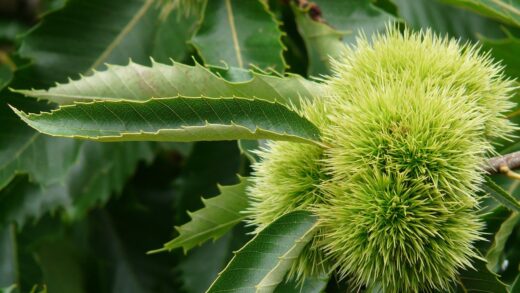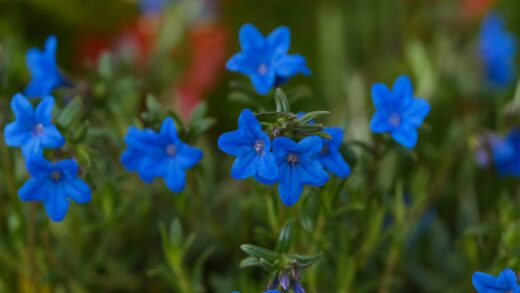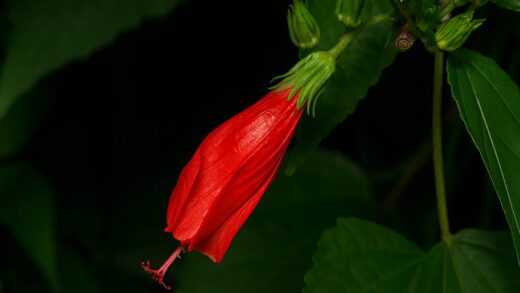The single most important environmental factor determining the success of a bluebeard shrub is the amount of sunlight it receives. This plant is an unapologetic sun-worshipper, and its entire performance, from its dense, bushy habit to the intensity and quantity of its flowers, is directly tied to the duration and quality of light it gets each day. To truly unlock the potential of this late-season bloomer, providing it with a location drenched in sunlight is not just a recommendation, but a fundamental requirement. Understanding why light is so crucial will help you select the perfect site and manage your plant for the best possible results.
For bluebeard, full sun is defined as a minimum of six to eight hours of direct, unobstructed sunlight per day. In this optimal light environment, the plant is able to photosynthesize at its peak capacity, creating the energy reserves needed to produce a spectacular floral display. The strong light also encourages the development of a sturdy, compact structure with short internodes—the spaces between the leaves on the stems. This results in a dense, well-branched shrub that can support its heavy load of blossoms without becoming floppy or weak.
When deprived of adequate sunlight, the plant’s response is both immediate and obvious. It will exhibit classic signs of light starvation, such as etiolation, where the stems become unnaturally long, thin, and “stretched” as they reach for a distant light source. The foliage will be sparse, and the overall form of the plant will be open and leggy rather than full and mounded. This structural weakness is often accompanied by a dramatic reduction in flowering, as the energy-deprived plant simply cannot afford the resources to produce blossoms.
Therefore, when choosing a location for your bluebeard, you must prioritize sunlight above almost all other factors. While the plant is adaptable to different soil types (as long as they are well-drained), it will not compromise on its need for light. A spot with southern or western exposure is typically ideal, as it ensures the plant receives the most intense light during the middle and latter parts of the day. Sacrificing even a few hours of direct sun can lead to a noticeably diminished performance from this otherwise spectacular shrub.
The importance of full sun exposure
Full sun exposure is the catalyst for nearly every positive attribute of the bluebeard shrub. The energy harnessed from sunlight through photosynthesis is the fuel that powers the plant’s growth and, most importantly, its reproductive cycle, which culminates in flowering. Without sufficient energy, the plant must prioritize basic survival over the resource-intensive process of creating blossoms. This is why a bluebeard in a shady spot may produce healthy-looking leaves but will yield few, if any, of the signature blue flowers it is prized for.
More articles on this topic
The quality of the blooms is also directly affected by light intensity. In full sun, the flower color will be more vibrant and saturated. The plant will also produce a greater number of flower clusters along each stem, resulting in a much more dramatic and impactful display. Sunlight also plays a role in the development of the silvery or grayish tones in the foliage of many popular cultivars, a feature that adds to their ornamental appeal. In lower light, this foliage color may appear duller and less distinctive.
Beyond aesthetics, full sun exposure contributes significantly to the overall health and resilience of the plant. Sunlight helps to warm the plant and dry the foliage quickly after rain or dew, which is a major factor in preventing the development of fungal diseases like leaf spot and powdery mildew. A plant weakened by a lack of light is also more susceptible to pest infestations. Therefore, providing ample sun is a key component of an integrated pest and disease management strategy, reducing the need for chemical interventions.
When planning your garden, it is essential to consider the sun’s path throughout the day and across the seasons. A spot that is sunny in the spring may become shaded in the summer as nearby deciduous trees leaf out. You must site your bluebeard where it will receive direct sun during its primary growing and blooming period from late spring through autumn. Observing the light patterns in your garden for a full day before planting is a wise investment of time that will pay dividends for the life of the shrub.
How light intensity affects flowering
The process of flowering is one of the most energy-intensive activities a plant undertakes, and for bluebeard, this energy is derived almost exclusively from sunlight. Light intensity directly correlates with the rate of photosynthesis, the process where the plant converts light energy into chemical energy in the form of sugars. These sugars are the fuel for all of the plant’s metabolic processes, including the formation of buds and the development of flowers. Higher light intensity means more fuel, which translates directly into more flowers.
More articles on this topic
The timing of bluebeard’s bloom, in late summer and autumn, is also related to light, specifically the changing photoperiod, or length of day. However, the sheer volume of flowers produced is a function of the energy the plant has been able to store throughout the entire growing season. A plant that has been basking in full sun from spring through summer will have accumulated a massive reserve of energy, enabling it to produce a truly prolific floral display. A plant in a shadier spot will enter the blooming season with a significant energy deficit, resulting in a much sparser show.
Inadequate light doesn’t just reduce the number of flowers; it can also affect their quality. The plant may produce smaller flower clusters, or the individual flowers may be less vibrant. In some cases of significant light deprivation, the plant may fail to set buds altogether, forgoing its reproductive effort for the year in order to conserve its limited resources for basic survival. This is a clear survival mechanism, as the plant will not expend energy on flowering if it does not have enough to sustain its own life.
If you have an existing bluebeard that is not flowering well, the first and most important factor to assess is its light exposure. Before you consider adding fertilizer or other treatments, honestly evaluate if the plant is receiving at least six hours of direct sun. Often, the solution to poor flowering is as simple as transplanting the shrub to a sunnier location in the garden. This single change can transform a lackluster plant into the stunning specimen it is meant to be.
Signs of inadequate light exposure
A bluebeard shrub will provide very clear visual cues when it is not receiving enough sunlight. The most obvious sign is a change in the plant’s growth habit. Instead of growing into a dense, compact mound, the shrub will become leggy and open. The stems will be noticeably longer and weaker, with greater distances between the leaf sets. This stretching, or etiolation, is the plant’s physical attempt to reach upwards and outwards in search of a better light source, and it results in a floppy, unattractive form.
The foliage of a light-deprived bluebeard will also tell a story. The leaves may be larger but thinner than on a plant grown in full sun, another adaptation to try and capture more of the available light with a greater surface area. The characteristic silvery-green or gray-green color of many cultivars will be less pronounced, often appearing as a plain, dull green. The overall density of the foliage will be reduced, giving the plant a sparse and skeletal appearance that lacks the lushness of a healthy specimen.
Of course, the most disappointing sign of inadequate light is a poor flowering performance. This can range from a significantly reduced number of flower clusters to a complete failure to bloom. If the plant does manage to produce flowers, they may be smaller, paler, and less impactful than they should be. This is the ultimate indication that the plant lacks the necessary energy reserves to complete its reproductive cycle successfully, and it is a direct consequence of insufficient photosynthesis.
It is important to differentiate the signs of low light from other potential problems. For example, while weak growth could also be a symptom of a nutrient deficiency, in the case of bluebeard, light is almost always the primary limiting factor. If your plant is showing these symptoms—leggy stems, sparse foliage, and poor flowering—your first and most likely diagnosis should be insufficient sun exposure. Addressing this foundational need is the essential first step to restoring the plant’s health and beauty.
Adapting to partially shaded locations
While it is crucial to emphasize that bluebeard is a full-sun plant, there are situations where a gardener may want to try growing it in a location with partial shade. It is important to set realistic expectations in such a scenario. A bluebeard grown in partial shade, which might be defined as four to five hours of direct sun per day, will never perform as spectacularly as one grown in full sun. However, if the partial shade is from morning or late afternoon sun, with several hours of intense midday sun, you may still achieve a reasonably good result.
If you must plant bluebeard in a less-than-ideal light situation, selecting a location that receives strong afternoon sun is generally better than one that only gets morning sun. The intensity of the afternoon sun is greater and can help to compensate for the reduced duration. You must also be prepared for the plant to have a more open and leggy growth habit. You can try to mitigate this somewhat with diligent pruning, cutting it back very hard in the spring to encourage as much dense new growth as possible.
In a partially shaded location, you will need to be particularly vigilant about disease prevention. The reduced sunlight and airflow in a shadier spot mean that the foliage will stay wet for longer periods, creating a more favorable environment for fungal diseases like powdery mildew. Ensure there is ample space around the plant and consider thinning out a few stems if the center becomes overly congested. Watering only at the base of the plant becomes even more critical in these conditions.
Ultimately, if your garden is predominantly shady, bluebeard may not be the right plant for your landscape. There are many beautiful shrubs that are specifically adapted to thrive in shady conditions. Forcing a sun-loving plant like bluebeard to live in the shade will likely lead to frustration and a perpetually underperforming plant. Choosing the right plant for the right place is a fundamental principle of successful gardening, and for bluebeard, the right place is indisputably in the sun.


















